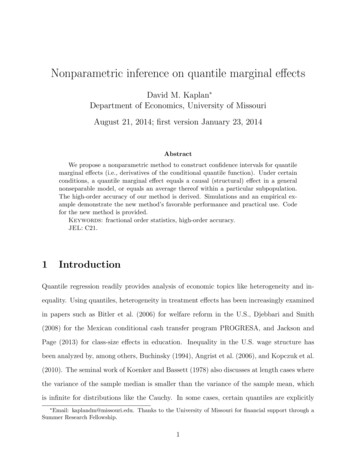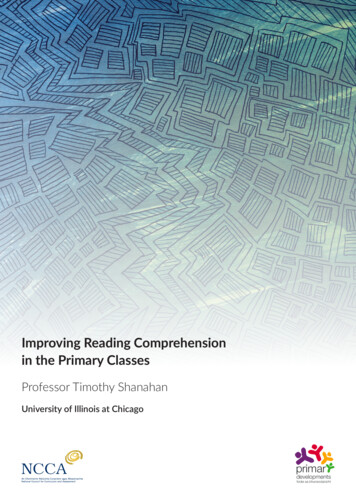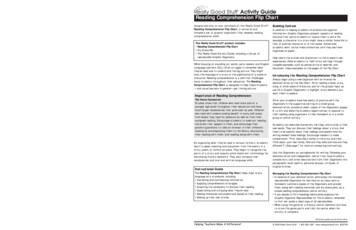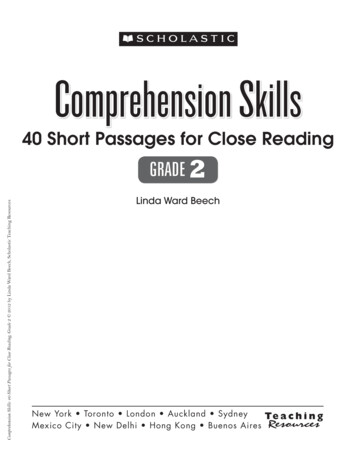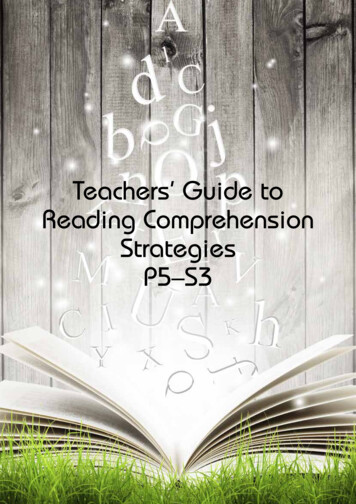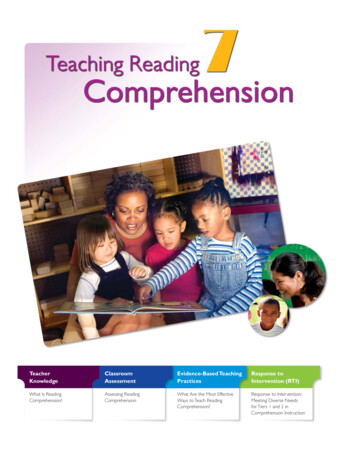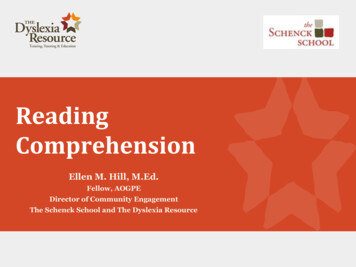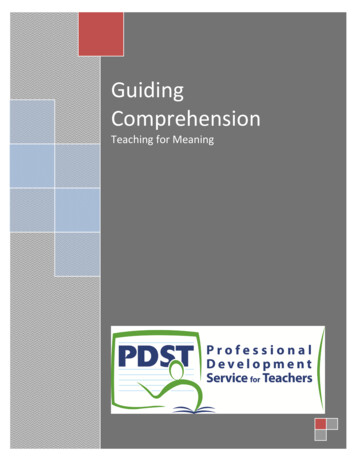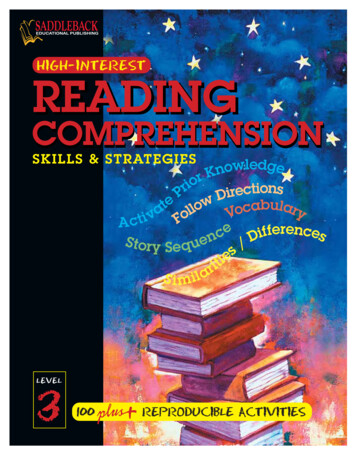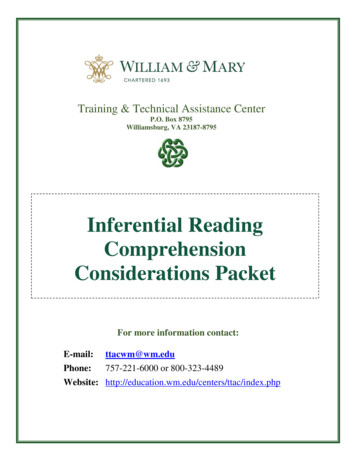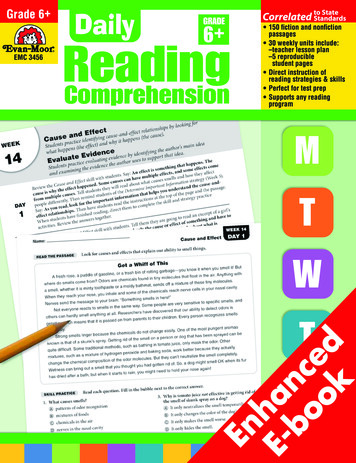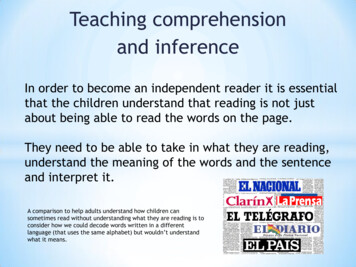
Transcription
Teaching comprehensionand inferenceIn order to become an independent reader it is essentialthat the children understand that reading is not justabout being able to read the words on the page.They need to be able to take in what they are reading,understand the meaning of the words and the sentenceand interpret it.A comparison to help adults understand how children cansometimes read without understanding what they are reading is toconsider how we could decode words written in a differentlanguage (that uses the same alphabet) but wouldn’t understandwhat it means.
Teaching comprehensionand inferenceThroughout Reception and Key Stage One, while thechildren are learning to decode words they are also learningcomprehension strategies.Initially this is done through the use of pictures and lookingat the meaning of individual words.
Teaching comprehensionand inferenceOnce a child is able to read slightly longer texts morefluently we begin to ask questions about what they haveread rather than what they can just see in the picture.Simple comprehension questions could be: What just happened? Why did the character do that? How do you think the character is feeling? Why? What might happen next? What do you think caused that to happen? Where are the characters? How did they get there?
InferenceInference skills are more complex comprehension skills.Inference means - filling in what is not written on the pageor working out what the author is trying to tell you usingclues and evidence from the text when it is not explicitlywritten.This is a skill which comes naturally to most adults butneeds to be explicitly taught to children.Lots of inference skills can be taught using pictures orsimple sentences.More confident readers might use a text extract.
Have a go using a pictureWho can you see in the photograph?Can you be certain they are boys?Can you tell where the children are?How do you think they are feeling?What do you think they are doing? What might they have been doing before this?What do you think might happen next?
Have a go using a simple sentenceJamie pedalled really hard, but halfway up thehill he had to get off and push.What was Jamie doing? How do you know that?Emily’s new kitten had done something verynaughty and Emily was so upset when she saw herfish and the broken glass on the floor.What had happened?
Have a go using a text extractBen slumped down with his head on his knees while his bigbrother Sam heaved a heavy sigh behind him. The holidayswere meant to be fun, but they still had another 4 weeks ofthis! The grass was damp from the rain last night but thesun beat down overhead. Through the still, sticky heatcame the sound of the cricket match in a nearby field.There was nothing else on the horizon but trees and fields.Sam looked around him and shook his head.Who are the children?What are they doing?How are the boys feeling?How does the author tell us the time of year?What do you think the boys have been doing before this part of the story?What might happen next?
Finding evidenceThe next step is to ask children to explain how or why theythink that.This can be very difficult and is a complex skill.We encourage the children to be reading detectives. Theymust try to back up their thoughts with evidence from thetext or the picture.The evidence should be a particular part of the image or aspecific word, phrase or sentence.“I wonder why .Is a good question to pose to children,especially children who are less confident ormay be anxious about answer comprehensionquestions.
Have a go using a pictureWho can you see in the photograph?Can you be certain they are boys? What makes you think that?Can you tell where the children are? What makes you think that?How do you think they are feeling? Why do you think that?What do you think they are doing? What might they have been doing before this?What do you think might happen next?
Have a go using a text extractBen slumped down with his head on his knees while his bigbrother Sam heaved a heavy sigh behind him. The holidayswere meant to be fun, but they still had another 4 weeks ofthis! The grass was damp from the rain last night but thesun beat down overhead. Through the still, sticky heatcame the sound of the cricket match in a nearby field.There was nothing else on the horizon but trees and fields.Sam looked around him and shook his head.Who are the children? How do you know?What are they doing? How can you tell?How are the boys feeling? How does the author show this in the text? Whatwords have been used instead of feeling words?How does the author tell us the time of year? What words or phrases tell usthis?What do you think the boys have been doing before this part of the story?Why do you think that?What might happen next?
Guided readingOnce a child is able to read fluently and have demonstratedthat they are able to answer questions about a text theywill begin reading in small groups.Guided reading involves the teacher working with a smallgroup of children on a text or an image and then facilitatinga group discussion.
Shared readingInference and comprehension questions are regularlydiscussed during shared reading sessions.Shared reading is when the teacher or another child readsaloud to the class.This is a good opportunity to ask more complex inferencequestions as the text tends to be of a more challenginglevel.Shared reading is also a good opportunity to: Model fluent, expressive reading Model effective reading strategies Develop children’s love for reading
Developing a love for readingOur main aims for teaching reading at Coleridge: Ensure all children have the skills to become successfulindependent readers. Ensure all children have a good understanding of whatthey are reading. Develop children’s love for reading and encouragethem to read for pleasure.
Developing a love for readingReading for pleasure has an immediate knock-oneffect on academic attainment (Evans et al, 2010)Children growing up in homes with many books getthe equivalent of 3 years more schooling thanchildren from bookless homes (Evans et al, 2010)All children (and many adults), regardless of their age orreading ability, enjoy listening to stories being read out loudto them. Children who regularly hear good literature read byan enthusiastic reader tend to have much better reading andwriting skills.
Developing a love for reading Our main aims for teaching reading at Coleridge: Ensure all children have the skills to become successful independent readers. Ensure all children have a good understanding of what they are reading. Develop children’s love for
